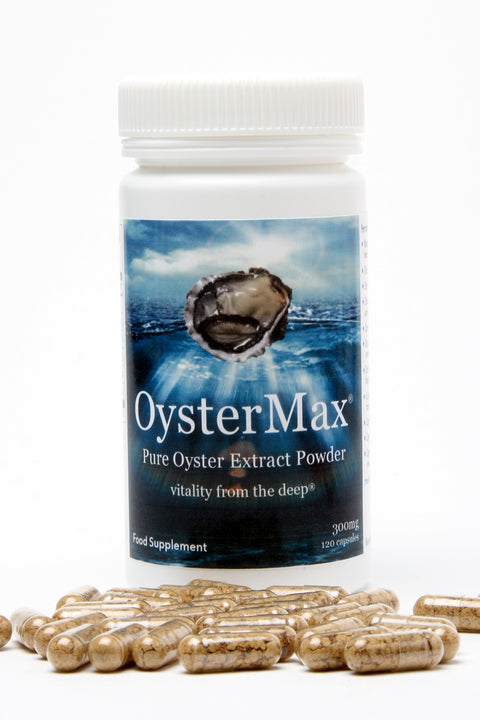What is OysterMax®?
OysterMax® is a pure oyster extract powder which has been encapsulated and contains significant amounts of naturally occurring nutrients essential for good health.
Each 120 capsule bottle of oyster extract capsules contains on average the concentrated extract of approximately 6 kg of fresh oysters. This extract contains significant amounts of zinc, copper, selenium and Iodine naturally occurring as nature intended. We do not use any fillers or excipients and bulking agents in OysterMax®. It is pure oyster powder.
What makes OysterMax® different?
THE BIOAVAILABILITY ISSUE:
OysterMax® is a natural shellfish extract. All of the nutrients are organic in origin making them 100% bio-available. The trace elements in OysterMax® are bound to transport molecules (peptides, amino acids) which makes them considerably more bio-available.
The high concentration of free amino acids and peptides are also directly available to the blood once consumed making them very fast acting. Synthetic mineral supplements on the other hand need to bind to transport molecules during digestion before they can be absorbed, which may affect their bioavailability.
All of the trace elements in OysterMax® are present in significant yet balanced concentrations, ensuring they all work in harmony as nature intended. None of the nutrients in OysterMax® are present in concentrations that could upset your bodies natural mineral and nutrient balance.
The Latest Research:
Further research is currently being carried out by our company on OysterMax® both in Ireland in 2 Universities, and by the Cellular and Microbiological Unit of the French Army to see what other bioactive properties OysterMax® contains.
The French investigation is being carried out as troops operating in hostile situations undergo massive oxidative stress on the body, and they want to see how OysterMax® can help alleviate some of the fatigue and illness associated with this.
OysterMax® Scientific Study 2015 -Fibroblast
OysterMax® Scientific Study 2015 - Antioxidant
REFERENCES:
- Prasad, A.S., 1993. Biochemistry of zinc.
- Pfaus, J.G. & Scepkowski, L.A. (2005). The biological basis for libido. Current Sexual Health Reports, 2, 95-100.
- Maret, W., 2001. Zinc biochemistry, physiology and homeostasis. Harvard Medical School.
- Chandra, R.K., and Dayton, D.H., 1982. Trace element regulation of immunity and infection, Nutr. Res. 2:721
- Heath ML, Sidbury R. Cutaneous manifestations of nutritional deficiency. Curr Opin Pediatr. 2006 Aug;18(4):417-22. Review.
- Fuchs E. Beauty is skin deep: the fascinating biology of the epidermis and its appendages. Harvey Lect. 1998-1999;94:47-77. Review.





